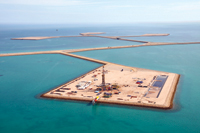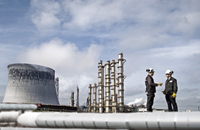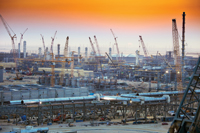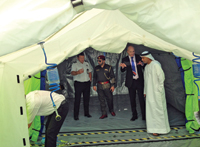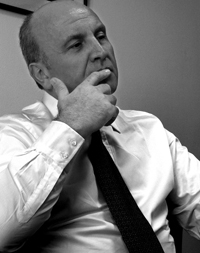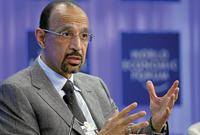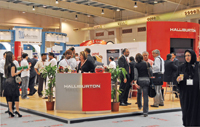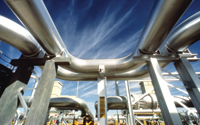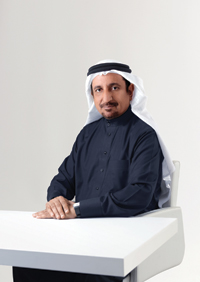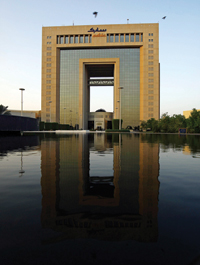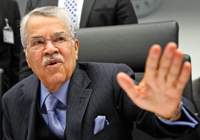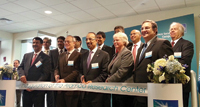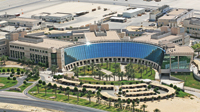
 Aramco ... goal of adding 160 billion barrels
Aramco ... goal of adding 160 billion barrels
SAUDI Arabia, the world’s largest oil exporter, has set a goal of adding 160 billion barrels to the kingdom’s oil reserves, a 20 per cent increase on current levels, Saudi Aramco CEO Khalid Al Falih says, as the company looks to continue efforts to find new Saudi oil and gas resources from both conventional and unconventional sources.
Al Falih’s comments come as Aramco also announced it had signed engineering contracts for the expansion of the Shaybah oil field. Al Falih says its reserves target was more than the combined current proven reserves of the US, Russia, China, the UK and Brazil.
The 2013 BP Statistical Review of World Energy puts Saudi Arabia’s proven oil reserves at 265.9 billion barrels at the end of 2012, while the combined reserves of the countries mentioned by Al Falih amounts to 157 billion barrels.
Al Falih says he hoped Aramco could accelerate exploration. “We want to drill 50 per cent faster than we do today and cut costs along the way,” he says.
Aramco’s research centres would contribute substantially to the effort to boost the kingdom’s oil reserves while improving the state petroleum company’s competence in the area of oil-field technology, Al Falih says.
While Saudi Arabia had long been a major oil exporter, Aramco is seeking to establish additional export-oriented integrated industries, he adds.
“In the future, we want to see our nation also become a leading exporter of technological solutions, and a valued contributor to the global pool of knowledge and innovation,” Al Falih says.
Aramco has signed contracts with international engineering and construction companies related to Saudi Arabia’s Shaybah Arabian Extra Light Crude Increment Project.
“This puts the Shaybah project on track to a new production plateau of 1 million barrels per day (mbpd) of Arab Extra Light crude oil,” the company says.
Aramco awarded a contract for the expansion of Shaybah’s central processing facility to South Korea’s Samsung Engineering. The target completion date for the 250,000 bpd capacity expansion was April 2016, it says.
China’s Shandong Electrical Power Construction was selected to upgrade the project’s power plant to combined cycle from simple cycle electricity generation and to add facilities to produce power from waste heat. Aramco says it expected to award the remaining contract for infrastructure facilities in January.
The Shaybah crude increment project is part of a larger development, the Shaybah NGL Recovery Programme, which includes nine other major contracts that are under way, Aramco says. Those contracts are scheduled for completion by the end of 2014.
While Saudi Aramco continues to invest at home, the company is also expected to boost its activities abroad. A South Korean government official says Saudi Aramco Overseas Company was willing to buy a further 28 per cent stake in South Korea’s third-largest oil refiner, S-Oil, a move that would boost its total holding to over 63 per cent.
 |
Al Falih ... concentrating on upstream |
At a meeting of business leaders with South Korean President Park Geun-Hye, Nasser Al Mahasher, CEO of S-Oil, says Saudi Aramco Overseas Company is prepared to buy a 28.4 per cent stake in S-Oil from South Korea’s Hanjin Energy.
Al Mahasher, CEO of S-Oil since March 2012, is a former senior official at Saudi Aramco, based in Tokyo.
In December, Hanjin Energy said it would divest its 28.4 per cent stake in S-Oil and intended to approach Saudi Aramco Overseas Company for a possible block sale.
Hanjin Energy, which is focused on renewable resources, wants to sell the stake to help improve the finances at its troubled affiliates. The 28.4 per cent stake in S-Oil is worth about $2 billion based on current share prices.
If Saudi Aramco agrees to the block sale deal, its stake would increase to 63.4 per cent from 35 per cent currently. The rest of the company is held by individual shareholders.
S-Oil operates a 669,000 bpd oil refinery in Onsan on South Korea’s southeast coast. S-Oil officials says they could not confirm Al Mahasher’s remarks, while Saudi Aramco could not be reached for comment.
Separately, Saudi oil minister Ali Al Naimi was quoted by state news agency SPA as saying that the country plans to offer shares in the 400,000 bpd Jubail refinery and the Sadara chemicals venture to Saudi citizens. The Jubail refinery is operated by Satorp, a joint venture between Saudi Aramco (62.5 per cent) and France’s Total (37.5 per cent).
Sadara – a joint venture between Aramco and the US’ Dow Chemical – is currently building a $20 billion chemical manufacturing base in Jubail. Upon completion, scheduled for 2016, it will have 26 production units with a combined output capacity of 3 million tonnes per year.
Meanwhile, Saudi Aramco has allocated SR470 billion ($125.3 billion) for the development of new oil projects, exploration, maintenance and other related engineering services in the next four years (2014-18).
Abdullah Al Warthan, manager of projects and strategic purchasing, says the volume of spending for the leading companies in a two-year period (2011-13) on local projects amounted to SR160 billion.
The Aramco official says that the local market would witness positive development through the creation of 900,000 jobs if 55 per cent of these spending was given to local firms.
Ahmed Al Khuwaitir, executive director of business development at Saudi Aramco, also reiterates the volume of spending would reach $125.3 billion (SR470 billion) in the next four years.
Saudi Aramco’s projects are meant to serve energy, develop lands, recruit national cadres, enhance the culture of free business, and support the SMEs, he says.
He says Aramco has set up “Waed” Centre to boost entrepreneurial innovation and the establishment of quality SMEs, facilitate regulatory measures and provide consultancy services to any project whereby small-scale enterprises could obtain all chances of growth and development.
The Saudi Aramco Entrepreneurship Centre Company Ltd (Waed LLC) supports entrepreneurship through: pre-funding support, funding through debt or equity financing and post-funding support.
Al Khuwaitir says Saudi Aramco had adopted initiatives to build enterprising Saudi cadres who could create new jobs working with companies with a view to expanding business opportunities and creating direct and indirect jobs poised to reach 300,000 in the next 15 years.
 |
Shaybah ... expanding |
With oil revenues accounting for around 90 per cent of total Saudi Arabian export earnings, up to 80 per cent of state revenues and at least 44 per cent of the country’s GDP, Saudi Arabia’s economy remains – despite attempts at diversification – dependent on oil. According to the Arab Petroleum Investments Corporation, the breakeven price for Saudi crude is $94 per barrel. The elevated price is a reflection of rising social spending expenditures and commitments that have been made in the wake of the Arab Spring.
Another analysis conducted by the Jadwa Investment, based in Riyadh, determined the break-even price will reach $118/barrel by 2020 and will result in rapid decline in the country’s cash reserves which will see the break-even price rise further. A May 2013 analysis conducted by the Centre for Global Energy Studies found that at an average Opec Basket price of $100/barrel, Saudi Arabia would need to produce just 8.3 mbpd to fund current spending plans, leaving room for a sizable theoretical cutback in capacity should it be justified.
Saudi Arabia has eased away from previous commitments to raise output capacity to 15 mbpd, with Al Falih telling the Wall Street Journal in December 2011 that rising volumes elsewhere left the country with ‘no need’ to ‘pursue output of 15 mbpd.’ That sentiment was reiterated by officials more recently in May 2013, as the impact of the unconventional boom in the US was downplayed.
However the country is going forwarding with a large investment programme. In October of 2012, Al Falih had confirmed a large capital expenditure programme of some $35 billion over the next five years targeting oil exploration and production (E&P) as part of an effort to maintain capacity in the world’s key swing producer and top crude oil exporter.
The large sum is an increase from previous pledges by Saudi Aramco to spend between $20-30 billion over five years to offset declining volumes from mature fields and sustain production capacity. Falling output from fields in decline has resulted in Aramco’s aggressive strategy to increase output with enhanced recovery projects and new upstream exploration. Despite being a prolific oil producer, much of Saudi Arabia remains underexplored, holding the potential of even greater hydrocarbons rewards. Further low lifting costs of $3-5 per barrel, despite the heavy processing required from some heavy and sour grades, makes Saudi oil comparatively economical when assessed against deepwater plays, where breakeven prices can be upwards of $50 per barrel.
Yet, with the majority of Saudi oil production derived from a handful of major fields, several of which are in decline, the need for investment to simply maintain output levels is essential. Although the Ministry of Petroleum maintains official decline rates of just 2 per cent annually, previous surveys have suggested the rate of decline may be in the range of 6-8 per cent per annum, translating into a heavy burden on Aramco to maintain production.
Saudi Arabia has seven refineries, which had a combined crude distillation capacity of around 2.1 mbpd at the end of 2011. Plans call for up to 2.14 mbpd of extra capacity by 2014 through the construction of three new refineries and the expansion of one more. In April 2010, US oil major ConocoPhillips announced that it was exiting a joint venture (JV) with state-owned Saudi Aramco that would have seen the company take part in the construction of a new 400,000 bpd refinery at the Red Sea port of Yanbu. In May 2011, Conoco was replaced at the project by state-run Chinese refiner Sinopec.
Saudi Arabia could become a net exporter of gasoline by 2014 following the completion of the new Yanbu and Jubail refineries, according to Al Falih. Although Saudi Arabia currently imports 60,000-70,000 bpd of gasoline, according to traders, Al-Falih says that the country only has a slight net deficit of the fuel. He says, however, that demand for the fuel was growing at 5.1 per cent annually, leading the country to look at both increasing production and constraining demand through policies such as setting mileage-per-gallon standards for cars.
Saudi Arabia’s proven natural gas reserves stood at 8,200 bcm in 2012, ranking the country fifth in the world, after Russia, Iran, Qatar, and Turkmenistan. Almost two-thirds of Saudi Arabia’s proven gas reserves consist of associated gas, mainly from the onshore Ghawar oil field and the offshore Safaniya and Zuluf fields.
The Ghawar oil field alone accounts for one-third of the total gas reserves. However, only 15 per cent of Saudi Arabia has been ‘adequately explored for gas’, according to Al Falih. Saudi Arabia claims vast unconventional gas reserves. Al Falih says that the kingdom potentially had around 5-6 tcm of shale gas and tight gas. There is limited foreign participation in Saudi Arabia’s gas sector through exploration JVs; however, the results have been mixed to-date.
Since the nationalisation of the Saudi energy industry in 1975, Saudi Aramco has effectively acted as the sole operator, although IOCs are now starting to participate in the development of natural gas reserves. Saudi Aramco is also the main refiner in the country, with around 75 per cent of total capacity and at least 50 per cent of the non-publicly traded shares of all JV refineries. This means that with the exception of the PNZ area, IOC involvement in Saudi Arabia is limited to gas production and downstream JVs, although service companies are regularly awarded construction and development contracts.
Saudi Aramco’s equivalent in petrochemicals is the state-owned Sabic group, which has been soliciting foreign investors in private petrochemical projects. Saudi Petrochemical Company (Sadaf), a JV between Sabic and Shell, has completed a $1 billion expansion programme that included a 700,000 tpy Methyl tertiary-butyl ether (MTBE) and an ethylene and polyethylene plant in Al Jubail with ExxonMobil. Sadaf also developed Saudi’s first independent power plant (IPP) at its Jubail petrochemical complex, which came onstream in 2005. It is uncertain whether or not the Saudi government will sell off more of its stake in Sabic in the near future.
Saudi Arabia’s role as swing producer within Opec means that the government generally seeks to maintain 1.5-2 mbpd of spare capacity. For now, plan to boost production capacity are on hold, but so calls by some to allow spare capacity to fall to support prices have also been disputed.



































































